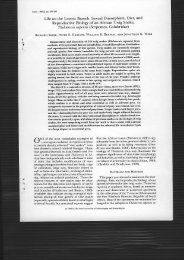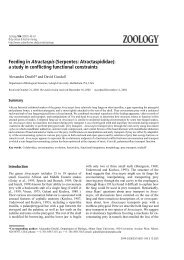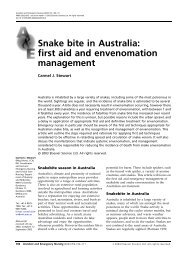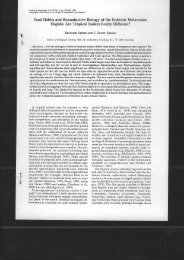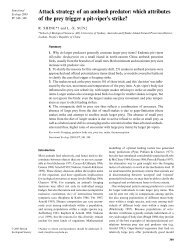Introduction - Kingsnake.com
Introduction - Kingsnake.com
Introduction - Kingsnake.com
Create successful ePaper yourself
Turn your PDF publications into a flip-book with our unique Google optimized e-Paper software.
Clinical Management of Snakebite in Papua New Guinea Chapter 1<br />
18<br />
16<br />
Mean Monthly Admissions<br />
14<br />
12<br />
10<br />
8<br />
6<br />
4<br />
2<br />
0<br />
JAN FEB MAR APR MAY JUN JUL AUG SEP OCT NOV DEC<br />
Month<br />
FIGURE 5: Seasonal frequency of admissions for snakebite in the Mekeo region of Central<br />
province between January 1997 and December 2001; increased frequency during the dry season<br />
months of November to April is statistically significant (p=0.04). (SOURCE: Williams et al, 2003).<br />
Lalloo et al (1995b) state that 57.9% of 221 envenomed patients and 51.6% of 128 nonenvenomed<br />
patients were bitten between November-April. Data on monthly admissions for<br />
snakebite were <strong>com</strong>pared to monthly rainfall; however rainfall itself was not shown to be a<br />
significant contributing factor.<br />
Williams et al (2002), reporting cases admitted to the PMGH ICU from January 1997 to<br />
December 2001 from across PNG, found that 54% occurred between November-April, and<br />
Williams et al (2003) found that 53.9% of snakebites in Mekeo occurred during the same<br />
months during this same period. McGain et al (2004) reported that 60% of fatal cases in the<br />
10 years from January 1992 to December 2001 occurred between November and April.<br />
Clinical Epidemiology and Envenomation Syndromes<br />
Local Indications of Envenomation<br />
The clinical syndromes of envenomation after snakebite in Papua New Guinea have been<br />
reported by several authors. Most reports relate to small case series of patients and, in most,<br />
the identification of the biting species is equivocal. Some of the consistently reported<br />
symptoms of snakebite over the last 40 years are shown in Table 1.<br />
Lymph node pain is a consistent feature after snakebite in Papua New Guinea, and tender<br />
enlargement of regional lymph nodes is reported in all published accounts. Venom injected<br />
subcutaneously typically enters the lymphatic system and drains via lymph nodes into the<br />
circulation, and tenderness or swelling of lymph nodes may be an indication of venom<br />
absorption. Trevett et al (1994a) stated that lymphadenitis was a particularly sensitive positive<br />
indication of envenomation and occurred in 93% of envenomed patients.<br />
- 1.15 -




